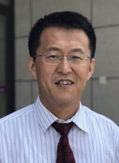1-9、High-Throughput Screening of Layered and 2D Materials and Their Applications to Energy Storage and Conversion
Zhen Zhou(周震)*
Institute of New Energy Material Chemistry, Nankai University, Haihe Educational Park, Jinnan District, Tianjin, 300350, China.
摘要:As energy crisis and environmental issue become increasingly serious, energy storage and conversion has been receiving extensive attention. Previously we investigated and designed new materials for photocatalytic water splitting and Na ion batteries via high-performance computations; however, instead of the design for a single material, high-throughput screening based on database is a more efficient approach to achieve more excellent candidates. Among various photocatalysts, two-dimensional (2D) materials exhibit native advantages in photocatalytic reactions, such as high surface-volume ratio and short diffusion distance for photo-generated electrons and holes. Also, Na-containing layered materials have attracted extensive attention since the layered structure ensures the reversible intercalation/de-intercalation of Na+ without serious lattice changes, leading to good cyclic stability and excellent ionic conductivity. In this work, we proposed a screening algorithm1 to search promising layered and 2D materials for photohydrolytic catalysts2 and Na ion batteries.3
With our algorithm over 50000 inorganic compounds from Materials Project Database were screened and 205 layered materials were obtained as candidates for water splitting photocatalyst. If those candidates are exfoliated into 2D monolayers, we confirmed 36 candidates with validated stability and appropriate band edge position for water splitting photocatalysis through phonon spectrum and band structure calculations. Moreover, fabricating 2D monolayers into type-II van der Waals heterojunctions can further enhance the photocatalytic performance due to the effective separation of photo-generated electron-hole pairs.

Figure 1. High-throughput screening of layered materials for Na ion batteries.
Also, we screened 38 kinds of sodium-based layered materials which can potentially be applied as insertion-type electrode materials for SIBs. Then the average voltage, volume change and Na ion mobility were further investigated by means of first-principles computations. Some materials with small volume changes and low Na ion diffusion barriers are promising candidates for SIBs.
Corresponding author: zhouzhen@nankai.edu.cn
DOI:10.12110/secondfmge.20181014.109

Zhen Zhou(周震)was born in Shandong, P. R. China in 1971. After he received his BSc (applied chemistry, in 1994) and Ph D (inorganic chemistry, in 1999) at Nankai University, P. R. China, he joined the faculty at Nankai University as a lecturer in 1999. Two years later, he began to work in Nagoya University, Japan with Professor Masahiko Morinaga (Ex-President of the Japan Institute of Metals) as a postdoctoral fellow, under the support of the Japan Society for the Promotion of Science (JSPS), and then he continued his research at EcoTopia Institute, Nagoya University for another two years. In 2005, he returned to Nankai University as an associate professor of Materials Chemistry. In 2011, he was promoted as a full professor of Materials Science and Engineering at Nankai University. In 2014, he was appointed as Director of Institute of New Energy Material Chemistry, Nankai University. So far, he has published over 250 scientific papers, 12 patents, and 4 book chapters, with over 13000 citations. His main research interest is the design, preparation and application of nanomaterials for energy storage and conversion.